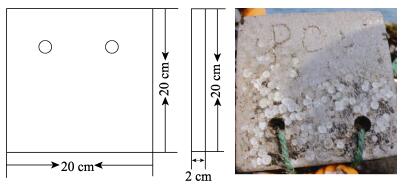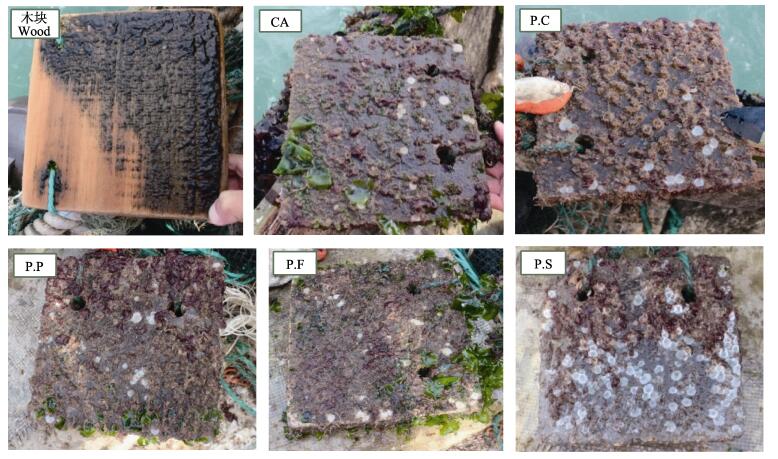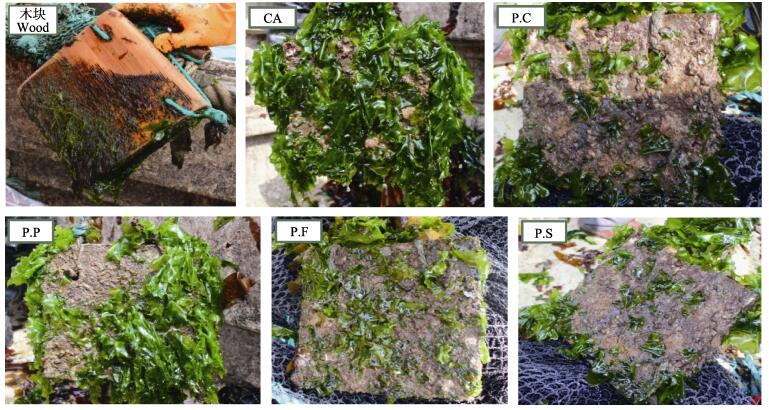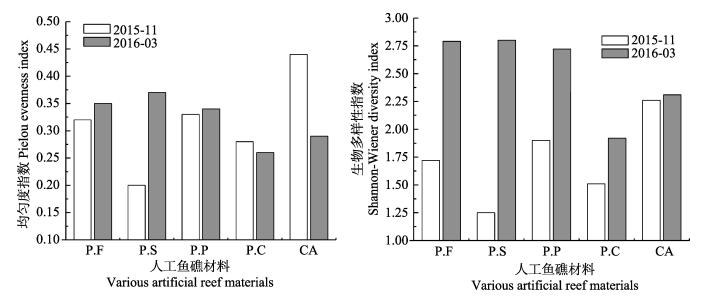2. 农业部海洋渔业可持续发展重点实验室 青岛市海水鱼类种子工程与生物技术重点实验室 中国水产科学研究院黄海水产研究所 青岛 266071
2. Key Laboratory of Sustainable Development of Marine Fisheries, Ministry of Agriculture, Qingdao Key Laboratory for Marine Fish Breeding and Biotechnology, Yellow Sea Fisheries Research Institute, Chinese Academy of Fishery Sciences, Qingdao 266071
人工鱼礁是将人工构造物有目的地投放于海底,用来改善海域生态环境、保护和增殖渔业资源的人工设施(Howe, 2003; Manoudis et al, 2005)。一般来说,人工鱼礁的投放会改变礁体周围几百米海域的水环境状况(Wilding et al, 2002),它不仅会影响营养盐的循环及传输(Alongi et al, 2008; 林军等, 2006),也会使沉积物发生生物化学变化(Falcao et al, 2007),同时为海洋生物提供良好的栖息环境(Henderson et al, 2014)。附着生物是人工鱼礁集鱼、诱鱼的主要生物环境因子,又是礁区渔业对象的主要饵料生物,可以作为海洋生物的饵料场、栖息地及庇护所(刘同渝, 2003; 李娇等, 2016)。附着生物的种类、组成及数量变化直接影响着人工鱼礁区的生态效应(周艳波等, 2010),可作为人工鱼礁效果评估的重要衡量指标。
不同材料的人工鱼礁,其生物附着种类和数量不同(Huang et al, 2006; 陈勇等, 2012; Kress et al, 2002; 刘秀民等, 2007; 张伟等, 2010)。人工鱼礁建造材料包括混凝土、木材、钢板、塑料、石块、轮胎以及废弃的轮船、火车等。混凝土由于其结构稳定,是应用最广泛的人工鱼礁材料之一(Walker et al, 2002; Baine, 2001)。Falace等(2002)对悉尼港的混凝土人工鱼礁进行生态效果评估,结果表明,礁体上生物附着效果良好而且底栖生物的丰度有所增加。目前,虽然对混凝土的利用及研究较多,但关于不同水泥类型的混凝土人工鱼礁差异的研究相对较少。不同类型的水泥成本相差较大,且成分及组成各异。铝酸盐水泥的主要成分为铝酸一钙及其他铝酸盐以及少量的硅酸二钙等。硅酸盐水泥的主要成分为硅酸三钙、硅酸二钙、铝酸三钙、铁铝酸四钙等。本研究针对复合硅酸盐水泥(P.C)、矿渣硅酸盐水泥(P.S)、火山灰质硅酸盐水泥(P.P)、粉煤灰硅酸盐水泥(P.F)和铝酸盐水泥(CA) 5种类型水泥制作的人工鱼礁的生物附着效果进行了实验研究,分析了5种人工鱼礁生态效益及经济效益的差别,以期为混凝土人工鱼礁水泥类型的选择提供理论依据。
1 材料与方法 1.1 样板制作5种水泥类型包括复合硅酸盐水泥(P.C)、矿渣硅酸盐水泥(P.S)、火山灰质硅酸盐水泥(P.P)、粉煤灰硅酸盐水泥(P.F)和铝酸盐水泥(CA),每种类型的人工鱼礁制作10个(表 1)。尺寸均为20 cm×20 cm×2 cm(图 1)。
|
|
表 1 鱼礁模型尺寸及数量 Table 1 Size and quantity of artificial reef models |

|
图 1 人工鱼礁挂板 Figure 1 Artificial reefs exposed to the marine environment |
2015年9月在山东省青岛市薛家岛海域投放。
1.3 挂样及取样方法将5种人工鱼礁挂板悬挂在网箱的缆绳上,均沉降到海面以下50 cm处,减少不同光照对人工鱼礁的影响。2015年11月和2016年3月,分别进行1次取样。每次采样、每种材料的鱼礁各取3个样,采样面积为10 cm×10 cm。取得的样品用玻璃瓶装,加入5%的福尔马林溶液固定,带回实验室分析鉴定。
1.4 数据分析附着生物量按照如下公式计算:
| $ P = m/s $ |
式中,P为附着生物量(g/m2),m为附着生物干重质量(g),s为取样面积(m2)。
附着生物群落多样性分析采用Shannon-Wiener多样性指数(H′)和Pielou均匀度指数(J)。计算公式如下:
| $ H' = - \sum\limits_{i = 1}^s {{P_i}} \log _2^{{P_i}} $ |
| $ J = H'/\log _2^s $ |
式中,S为采集样品的种类总数,Pi为第i种的个体数与样品中的总个体数的比值(Ni/N)。
优势种由优势度指数(Y)确定,Y > 0.02为优势种。计算公式如下:
| $ Y = \left({Ni/N} \right) \times {f_i} $ |
式中,fi为第i种出现的个体数,N为采集样品中的所有种类总个体数,Ni为第i种出现的频率。利用软件Primer 5计算不同礁体上附着生物群落的多样性参数。采用SPSS 17.0软件进行统计学分析,单因子方差分析(One-way ANOVA)检验组内差异,P < 0.05为差异显著,P < 0.01为差异极显著。
2 结果 2.1 礁体附着生物种类及生物量2次取样附着生物生长状况如图 2、图 3所示,前后2次效果差异显著,且不同材质人工鱼礁上附着生物量有显著差异。附着生物大多数属于温带黄渤海常见物种(表 2)。2次取样生物种类总数量差异较大,第1次取样生物种类数为13种,其中,红藻门2种、绿藻门2种、褐藻门2种、节肢动物门4种及环节动物门3种;第2次生物种类数为27种,其中,红藻门4种、绿藻门3种、褐藻门2种、节肢动物门6种、环节动物门8种及软体动物门、腔肠动物门、纽形动物门、扁形动物门各1种。

|
图 2 2015年11月附着生物生长状况 Figure 2 The growth status of fouling organisms in November, 2015 |

|
图 3 2016年3月附着生物生长状况 Figure 3 The growth status of fouling organisms in March, 2016 |
|
|
表 2 不同材料人工鱼礁附着生物种类 Table 2 Different kinds of material adhesion on artificial reefs |
从不同水泥类型上看(表 3),2015年11月P.S上生物种类为7种,P.F、P.P、CA上为5种,P.C上为3种;2016年3月生物种类由多到少为P.F、CA、P.S、P.P、P.C,种类分别为17、15、12、11、8。2015年11月,不同材料人工鱼礁上附着生物量从大到小依次为P.P、P.S、CA、P.F、P.C,生物量分别为888.29、755.43、752.07、620.11、402.01 g/m2。2016年3月,各实验组附着生物量均有明显增加,CA组附着生物总量最多,为1956.94 g/m2;其次分别为P.P、P.F、P.C、P.S,生物量分别为1601.44、1453.06、1254.63、1072.43 g/m2。2次取样中,生物量最高为CA组,其次为P.P及P.F两组。
|
|
表 3 不同材质人工鱼礁的附着生物种类总数及生物量 Table 3 The species and biomass of the fouling organisms on different artificial reefs |
结果显示(图 4),2015年11月,Pielou均匀度指数分别为CA > P.P > P.F > P.C > P.S,依次为0.44、0.33、0.32、0.28、0.20,其中,P.P与P.F差异不显著(P > 0.05),其余各组均有显著差异(P < 0.05)。2016年3月,分别为P.S > P.F > P.P > CA > P.C,Pielou均匀度指数依次为0.37、0.35、0.34、0.29、0.26,其中,P.F、P.P两组差异不显著(P > 0.05)。CA、P.C两组均匀度指数下降,其余各组均上升。第1次取样Shannon-Wiener多样性指数由高到低依次为CA > P.P > P.F > P.C > P.S,分别为2.26、1.90、1.72、1.51、1.25,各组均存在显著差异(P < 0.05)。第2次取样依次为P.S > P.F > P.P > CA > P.C,Shannon-Wiener多样性指数依次2.80、2.79、2.72、2.31、1.92,其中P.S、P.F两组差异不显著(P > 0.05),其余各组均存在显著差异(P < 0.05)。2次取样Shannon-Wiener多样性指数平均值最高为P.P组,其次为CA及P.F组,最低为P.C组。

|
图 4 人工鱼礁上附着生物Shannon-Wiener多样性指数和Pielou均匀度指数 Figure 4 Shannon-Wiener biodiversity index and Pielou evenness index of fouling organisms on artificial reefs |
2015年11月,CA、P.S两组分别有6个优势种,P.P组有5个,P.F组有4个,P.C组有3个。东方小藤壶(Chthamalus challenger)在P.C组占绝对优势,优势度为0.48。钩虾(Gammarus sp.)在P.F、P.P、P.S、CA四组中占绝对优势,优势度分别为0.46、0.28、0.66、0.37。2016年3月,P.F及P.P两组优势种分别为9个,CA及P.S两组分别有8个优势种,P.C组有5个。孔石莼(Ulva lactuca L.)在各组中均占绝对优势,小肌蛤为5种共有的优势种。
3 讨论附着生物生长受温度、盐度、光照、潮汐、海浪这些环境因子的影响(Su et al, 2009; 唐贵明, 20081); 陈翔峰等, 2011),2次采样时间间隔为4个月,附着生物的生物量、种类、群落结构及优势种都存在差异。2015年11月,由于水温较低、投放时间短,附着生物量和种类总数均较少。2016年3月,附着平均生物量和生物种类增加,约为第1次的2倍左右,生物种类数由第1次的13种增加到第2次的27种。优势种也发生了变化,5种不同水泥类型的混凝土礁体优势种由钩虾和东方小藤壶均变为孔石莼。Shannon-Wiener多样性指数和Pielou均匀度指数是2种表征群落稳定性的指标。一般来说,一个群落的多样性指数和均匀度指数越高,则预示着该群落所属的生态系统越稳定和成熟(孙军等, 2004)。Shannon-Wiener多样性指数(H′)也有所升高,第1次取样平均为1.73,第2次平均为2.51。Pielou均匀度指数(J)两次取样变化较小,各组平均值由0.31变为0.32。生物群落更加成熟和稳定。
1) Tang GM. Study on biodiversity of macrobenthos in the rocky intertidal zone of Qingdao. Master's Thesis of Ocean University of China, 2008, 30–36 [唐贵明.青岛岩相潮间带大型底栖生物生物多样性调查研究.中国海洋大学硕士研究生学位论文, 2008, 30–36]
钢筋混凝土人工鱼礁对海洋生物的诱集效果明显高于油井类、舰船类等人工鱼礁(江艳娥等, 2013)。张伟等(2010)对大亚湾杨梅坑人工鱼礁区的混凝土鱼礁和铁制鱼礁上的附着生物进行了调查,发现混凝土礁体比铁制礁体上附着生物生物量高,说明混凝土人工鱼礁具有较好的生物附着效果。本研究中,5种不同水泥类型的人工鱼礁中,P.F、CA两组生物附着种类最多,CA、P.P、P.F三组生物量较多,P.F、P.S、P.P三组生物群落较为稳定,而P.C组生物种类及生物量最少,Shannon-Wiener多样性指数和Pielou均匀度指数均最低。由此可知,铝酸盐水泥(CA)及粉煤灰硅酸盐水泥(P.F)制成的人工鱼礁生物附着效果好。最常用的复合硅酸盐水泥(P.C)人工鱼礁生物附着效果相对较差。
从成本上看,铝酸盐水泥(CA)的成本约为普通水泥的2–4倍,主要用于紧急军事工程、修桥、筑路以及抢修(堵漏)等工程中,作为人工鱼礁材料的性价比不高。火山灰质硅酸盐水泥(P.P)目前使用比较少,生物附着效果不突出,也不建议使用。最为常用的复合硅酸盐水泥(P.C)成本比粉煤灰硅酸盐水泥(P.F)及矿渣硅酸盐水泥(P.S)高,其生物附着总量最少,生态效益相对较差。而粉煤灰硅酸盐水泥(P.F)不仅成本低,而且生物附着效果较好,经济效益和生态效益均占优势。Kress等(2002)研究发现,在含40%–60%粉煤灰的礁体上,藻类附着效果要显著好于纯混凝土和纯粉煤灰礁体。粉煤灰和碱渣制作的人工鱼礁具有较高抗压强度、无污染、造价低及结构稳固等优点(刘秀民等, 2014; 覃维祖, 2006)。综上所述,粉煤灰硅酸盐水泥制作的人工鱼礁不仅可以利用工业残余矿渣,减少工业废渣对环境污染的压力,同时可以作为人工鱼礁材料,生物附着效果较好,具有较高的生态效益。
| Alongi DM, Trott LA, Pfitzner J. Biogeochemistry of inter-reef sediments on the northern and central Great Barrier Reef. Coral Reefs, 2008, 27(2): 407-420 DOI:10.1007/s00338-007-0347-2 | |
| Baine M. Artificial reefs: A review of their design, application, management and performance. Ocean and Coastal Management, 2001, 44(3): 241-259 | |
| Chen XF, Hou J, Mu ZJ, et al. Study on the adhesion and variety of marine fouling organisms. Development and Application of Materials, 2011, 26(1): 24-28 [陈翔峰, 侯健, 穆振军, 等. 海洋污损生物变化及附着规律研究. 材料开发与应用, 2011, 26(1): 24-28] | |
| Chen Y, Tian Tao, Zhao ZY, et al. The feasibility of congealing stone materials used as artificial reef--the species composition and biomass of organisms attached to the tested modules. Journal of Dalian Ocean University, 2012, 27(4): 344-349 [陈勇, 田涛, 赵子仪, 等. 凝石胶凝材料作为人工鱼礁材料的可行性研究Ⅱ. 大连海洋大学学报, 2012, 27(4): 344-349] | |
| Falace A, Bressan G. Evaluation of the influence of inclination of substrate panels on seasonal changes in a macrophytobenthic community. ICES Journal of Marine Science, 2002, 59(5): 116-121 | |
| Falcao M, Santos MN, Vicente M, et al. Biogeochemical processes and nutrient cycling within an artificial reef off Southern Portugal. Marine Environmental Research, 2007, 63(5): 429-440 DOI:10.1016/j.marenvres.2006.12.001 | |
| Henderson MJ, Fabrizio MC, Lucy JA. Movement patterns of summer flounder near an artificial reef: Effects of fish size and environmental cues. Fisheries Research, 2014, 153(5): 1-8 | |
| Howe JC. Artificial reef evaluation with application to natural marine habitats: William Seaman Jr. (Ed.); CRC Press, New York, NY, 2000. Fisheries Research, 2003, 63(2): 297–298 | |
| Huang ZR, Liang XY, Zeng J. Preliminary study on effects of accrete organisms of artificial reef material. South China Fisheries Science, 2006, 2(1): 34-38 [黄梓荣, 梁小芸, 曾嘉. 人工鱼礁材料生物附着效果的初步研究. 南方水产, 2006, 2(1): 34-38] | |
| Jiang YE, Chen PM, Lin ZJ, et al. Comparison of effectiveness of various artificial reef materials for fish attraction. Journal of Applied Oceanography, 2013, 32(3): 418-424 [江艳娥, 陈丕茂, 林昭进, 等. 不同材料人工鱼礁生物诱集效果的比较. 应用海洋学学报, 2013, 32(3): 418-424] | |
| Kress N, Tom M, Spanier E. The use of coal fly ash in concrete for marine artificial reefs in the southeastern Mediterranean: compressive strength, sessile biota, and chemical composition. ICES Journal of Marine Science, 2002, 59(5): 231-237 | |
| Li J, Gong PH, Guan CT, et al. Carbon sequestration of additives of artificial reefs and its effect on carbon fixation of Ostrea Plicatula. Progress in Fishery Sciences, 2016, 37(6): 100-104 DOI:10.11758/yykxjz.20151215002 [李娇, 公丕海, 关长涛, 等. 人工鱼礁材料添加物碳封存能力及其对褶牡蛎(Ostrea plicatula)固碳量的影响. 渔业科学进展, 2016, 37(6): 100-104] | |
| Lin J, Zhang SY. Research advances on physical stability and ecological effects of artificial reef. Marine Fishery, 2006, 28(3): 257-262 [林军, 章守宇. 人工鱼礁物理稳定性及其生态效应的研究进展. 海洋渔业, 2006, 28(3): 257-262] | |
| Liu TY. Bait effect of artificial reefs. Jiangxi Fishery Sciences and Technology, 2003(4): 37-38 [刘同渝. 人工鱼礁的饵料效应(一). 江西水产科技, 2003(4): 37-38] | |
| Liu XM, Zhang HH, Luo MW. Research on building of artificial fish-reef by using fly ash and alkaline dregs. Journal of Building Materials, 2007, 10(5): 622-626 [刘秀民, 张怀慧, 罗迈威. 利用粉煤灰和碱渣制作人工鱼礁的研究. 建筑材料学报, 2007, 10(5): 622-626] | |
| Manoudis, Antoniadou C, Dounas C, et al. Successional stages of experimental artificial reefs deployed in Vistonikos Gulf (North Aegean Sea, Greece): Preliminary results. Belgian Journal of Zoology, 2005, 135(2): 209-215 | |
| Su ZX, Xiao H, Huang LM. Effect of fouling in Daya Bay Scallop chlamysnobilis (reeve) cultivation: Food competition and nutrient release. Marine Science Bulletin, 2009, 11(2): 37-44 | |
| Sun J, Liu DY. The application of diversity indices in marine phytoplankton studies. Acta Oceanologica Sinica, 2004, 26(1): 62-75 [孙军, 刘东艳. 多样性指数在海洋浮游植物研究中的应用. 海洋学报, 2004, 26(1): 62-75] | |
| Tan WZ. The application of fly ash in concrete. Fly Ash Comprehensive Utilization, 2006, 14(2): 1-7 [覃维祖. 粉煤灰在混凝土中的应用技术. 粉煤灰综合利用, 2006, 14(2): 1-7] | |
| Walker BK, Henderson B, Spieler RE. Fish assemblages associated with artificial reefs of concrete aggregates or quarry stone offshore Miami Beach, Florida. Aquatic Living Resources, 2002, 15(2): 95-105 DOI:10.1016/S0990-7440(02)01154-3 | |
| Wilding TA, Sayer MDJ. Evaluating artificial reef performance: Approaches to pre-and post-deployment research. ICES Journal of Marine Science, 2002, 59(5): 222-230 | |
| Zhang W, Li CH, Jia XP, et al. Ecological characteristics of fouling organisms on concrete and steel of in Daya Bay. Marine Environmental Science, 2010, 29(4): 509-512 [张伟, 李纯厚, 贾晓平, 等. 大亚湾混凝土鱼礁和铁制鱼礁附着生物生态特征. 海洋环境科学, 2010, 29(4): 509-512] | |
| Zhou YB, Cai WG, Chen HG, et al. The mechanism and research progress on fish attraction technique for artificial reef. Marine Fishery, 2010, 32(2): 225-230 [周艳波, 蔡文贵, 陈海刚, 等. 人工鱼礁生态诱集技术的机理及研究进展. 海洋渔业, 2010, 32(2): 225-230] |



